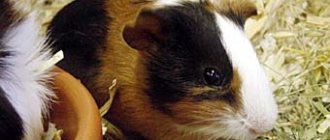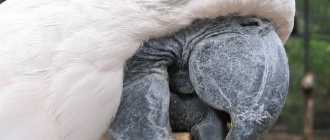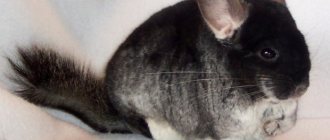Preparation
So, if you decide to have this funny creature at home, be prepared for the fact that many not entirely pleasant surprises await you, such as, for example, bowel movements in the most inappropriate places. For example, it is much easier to train a cat to use a litter box than a ferret. Be patient, pay maximum attention to the animal, and you will be able to reach an agreement; the ferret will get used to you and will understand you.
Before you go shopping and before litter box training your ferret, you need to learn as much as possible about his habits, behavior, physiology and tastes. Each ferret is an individual, but ferrets are animals and they have common traits.
What to buy before getting a ferret
Before a ferret appears in the house, it is necessary to purchase a certain minimum of items to keep the animal.
Cell
Try to decide in advance whether you are going to keep your ferret in a cage most of the time or, on the contrary, it will only be needed occasionally: the type and parameters of the cage depend on this. For permanent maintenance, a large, spacious cage is required, preferably two or three tiers.
Types of trays for ferrets
If your ferret stubbornly ignores the litter box, it makes sense to try changing the litter box itself to a different configuration. Today there are several types of trays:
- A regular cat cat, equipped with a net. The advantage of such a tray is that it is always dry, since urine flows into the tray. But since the ferret defecates against the corner, he may miss the edge. It is necessary to wash the tray quite often, at least once a day, since otherwise the animal may not want to go to it.
- The second type of tray is a litter tray. The design is a tray with a removable side into which any filler is poured. If the tray is exactly like this, but the ferret does not want to go there, you can try to change the litter itself. The problem is that regular cat litter is not very good for ferrets. Wood and clay granules can stick and cause skin irritation. It is better to do without filler altogether, washing the pot several times a day.
- The third type is a corner tray. Its shape is ideal for ferrets as it has high sides and a low front. You can put cat litter or paper in the base of the tray. You can put a diaper on. But paper and diapers must be changed frequently to ensure that the toilet is always clean. You need to wash the tray without using detergents, since it is important not to wash away the specific smell of the animal, by which it determines where its toilet is.
It is necessary to prepare the house for the ferret to stay in it. The cage should be spacious and clean. The best bedding is rags and unnecessary clothing. These rags will then be useful in teaching your ferret to go to the toilet only in the designated places. One of the trays needs to be placed directly in the cage and firmly attached to the bars - playful animals simply love to move everything from place to place.
Requirements for trays
Many novice ferret breeders don’t think that it’s not so much the sawdust, but the tray itself! Have you seen a ferret go to the litter box? He enters it with all his paws, turns his back to the wall, sits down and raises his tail. Which means:
- The tray should be the size of the ferret. The larger the ferret, the larger the tray. Based on this rule, corner trays, which are advertised by sellers, due to the small space, are suitable only for small puppies or females.
- The ideal litter box is a rectangular cat litter box with a mesh . You can sprinkle any filler under the mesh or leave nothing and wash the tray 2 times a day. NEVER place sawdust in bulk on the bottom of the cage, or in a tray without a mesh! Firstly, even in an apartment, a ferret will look for piled sawdust in the corner, or he will pee in such a tray once, and everything else will be nearby. And besides, he carries sawdust around the apartment on his paws.
- Tray height. The smaller the ferret, the shorter its legs , and the lazier it will be to climb over the high side. If you notice that the ferret gets to the toilet, and then, without getting into it, turns around and goes next to it, cut the side as low as the structure allows, making a passage for him.
- Trays in the room. Trays should be the same in design as in the cage . The ferret himself will show you the places where you need to put them. Let there be several trays in the room rather than piles in the middle of the room :)))). One of my favorite places is at the exit from the room, under the door. Ferrets do not tolerate well if they are impatient. Therefore, they quickly run to the nearest tray. 60% hits for a ferret walking around the apartment, this is normal.
- Accustom your ferret to the tray by placing him on it like a child after 5-10 minutes. after waking up, and 15-20 minutes after eating. If the ferret has done something by, blot the puddle and put the smelling piece of paper in the tray. Next, for training, you can use the technique described for litter training lapdogs. You can find a lot of materials on the Internet.
You should know that it is IMPOSSIBLE to punish a ferret for pooping in the wrong place! Only positive reinforcement. Otherwise, he will shit in such inaccessible places that you will be tortured to clean up!
Interesting examples
Making cages for ferrets yourself has a number of advantages, which include saving money and the ability to create any design to suit the style of the room. Let's consider the most original models.
- Multi-tiered structure made of wood and plexiglass. Such a house will serve as a comfortable place for the animal to live and will fit perfectly into the interior of the room. The only thing is that plexiglass does not allow oxygen to pass through, so you will have to drill small holes in it around the perimeter. In this case, the roof should be installed sloping, gable or flat. Externally, the structure can be decorated with dry branches from trees and shrubs, and the glass can be painted with patterns.
- Cage in the form of a castle. It is recommended to make such a house from wooden blocks, plywood and wicker. To give the structure originality, it should include several floors, each of which will be equipped with certain accessories. First, a frame is prepared from beams, it is sheathed with plywood blocks and the assembly is completed with wicker decor, it is done from the outside.
In order for the housing to be decorated in the same design, it is recommended to purchase drinking bowls and feeders to match the color of the vine, and knit hammocks with your own hands from thick threads. Externally, the house can be decorated with artificial lakes and flower beds lined with pebbles.
For an overview of a ferret cage measuring 1.4 x 0.75 x 0.5 m, see below.
Where does a ferret go to the toilet?
You need to train your ferret to go to the litter tray from the very first days, as soon as he settled in your neighborhood. The main factor in achieving a positive result is patience. You need to understand that a ferret is not a dog and is much slower and harder to train.
It is easiest to toilet train females and young animals; males react more difficult to training.
Juveniles
While still blind, ferrets can crawl out of the nest and determine where food is and where the toilet is by smell. If the mother of the babies is clean and toilet trained, then by the age of one and a half months her offspring will be free to do the same. To prevent the young animals from shitting anywhere, every corner of the cage must be occupied with something.
It is very important that the latrine is cleaned after each animal defecates. The ferret will not go to a dirty toilet, but will do its job somewhere else.
Small animals defecate about 10 minutes after sleeping or eating. Try to be nearby and show your pet where the right place is. It is very rare, but it also happens that the ferret himself determines a convenient place for himself where the toilet will be.
Adult pets
If you are lucky enough to buy an animal that already knows how to use the toilet, then you will just need to show where it is. Be sure to wait for the animal to empty itself in the right place. Praise your pet and give him a treat. If an animal poops where it shouldn't, take its feces and spread it on the tray. Then show your pet where to defecate.
As a rule, one acquaintance with the toilet is enough. But sometimes it happens that the new owner puts in a tray that is different from the usual one or adds a different filler. In this case, you will have to patiently teach your pet to go to the new toilet.
Sometimes adult ferrets choose a different angle each time to defecate. In this way, the animal wants to assert itself or simply doesn’t like something. This is especially noticeable for individuals who have moved to a new place of residence or during their growing up period.
How to train an animal to go to the litter box
Ferrets have different attitudes towards the litter box: some use it regularly and almost never shit in the wrong place, others are more irresponsible, and still others (albeit a minority) ignore the litter box altogether.
There are several nuances in training a ferret to use a litter box:
- A ferret may ignore a newly purchased tray. In this case, it is worth getting a little “dirty” in his feces.
- Ferrets do not hesitate to share a litter box with a cat. But keep in mind that cats do not like to share a litter box with a ferret.
- If the ferret walks freely around the apartment, it will be better if the trays are placed in different corners of the apartment.
We must remember that a ferret does not shit where it eats or where it sleeps. Corners where there is food or rags will not be chosen by the ferret as a toilet.
Females and puppies are easier to toilet train than males and adult animals. Don't demand too much from your pet - if he relieves himself in the specified place 80% of the time, that's very good. But the remaining 20% is not a problem: ferret urine and excrement do not have a strong odor.
Ferrets are clean and will not use a heavily soiled litter box. Therefore, a tray used without filler must be washed at least once a day. If you use litter (for example, Catsan), clean the tray as it gets dirty.
If the room is large, you will have to install two or more trays. Ferrets have fast digestion and little patience, and are unlikely to run to the toilet if it is too far away. If the animal roams freely in several rooms, place a tray in each of them. A ferret may not want to use the same litter box as a cat, for example, but several ferrets will share a litter box.
Stage one: training to use a tray in a cage
For the first few days, keep your ferret in a cage using the same tray that you plan to use later indoors.
Having woken up, the ferret relieves itself within 3-5 minutes. This feature needs to be used: wake the animal, hold it in your arms until it begins to show concern, and then put it in the tray. As soon as your ferret relieves himself, praise him, give him a treat and let him out for a walk. Approximately every 30 minutes, place the animal in a cage on a tray.
If your ferret takes a crap during a walk, sternly reprimand him and lock him in a cage. Treat the area where the ferret relieved himself with an odor-eliminating product (DezoSan, Nature's Miracle). Try to monitor the animal and avoid such situations.
When the ferret gets used to defecating in the litter box, you can let him live freely in the house. First, give him one room at his disposal and do not allow him into others until he gets used to using the toilet in a disciplined manner.
Stage two: indoor litter box training
Place the litter box in a location where your ferret is more likely to use the litter box. Most likely, this will be a corner of the room, located close to the shelter. Place some animal excrement in the tray. You may be lucky and the animal will relieve itself in the place you choose.
Pay close attention to where your pet goes for the first time. Transfer the excrement to a tray, thoroughly wash the floor and wipe it with an odor-eliminating agent. If the smell remains, the animal will likely want to use the area again. For the first mistake, do not punish too harshly - after all, the ferret does not yet know where to relieve himself; you just need to let him know that you are unhappy.
If the place or one of the places chosen by the animal for the toilet suits you, this will make the task easier. Remember that when you accustom your ferret to the litter box, you are looking for a compromise with him: he “shows” you the places that are most preferable from his point of view, and you prohibit those that are unacceptable from your point of view.
When defecating, the ferret takes a characteristic pose: it begins to back away slightly, arching its back, and raises its tail. When you see this, grab the animal and quickly carry it to the tray. If you didn’t have time and the ferret relieved himself in the wrong place, punish him, and then be sure to take him to the tray.
Punishment will only give results if the animal is caught “in the act of a crime” or a little time has passed, otherwise there is no point in punishing. Learning will be greatly accelerated if you can constantly observe your pet for several days.
Don’t forget to praise him and reward him with a treat every time the animal relieves itself in the tray. A little time will pass and the ferret will understand why he can get a treat.
Where to put the tray
In the room, it is better to install the tray somewhere in the corner, not far from the ferret’s bed - try to guess which place your pet would choose. If the ferret ignores the tray and chooses another place, collect the excrement and put it in the tray, and carefully treat the floor to remove dirt and odor so that the animal is not tempted to “offend” again.
If the place that the ferret has chosen for coping is suitable for installing a tray, move the tray there, this will significantly simplify the task.
You should know that ferrets have very fast digestion, and, having decided to relieve themselves, the animal will not run long to the tray, but will choose another convenient place. Therefore, if your pet moves freely throughout the apartment, then it is advisable to have a tray in every room.
So, what should a cell be like?
Spacious. Hori are very active animals; they do not like to sit still, unlike, for example, decorative rabbits, so they need space for their active activity. In addition, it is necessary to equip the cage with all kinds of “simulators” to maintain the animal’s physical activity, which is especially important in adolescence.
Such simulators can be special pipes, scratching posts, nets, bags of rags, containers with sand, and so on. Now you understand that such a number of accessories will require a lot of space, therefore, it is advisable that the cage consist of several floors with shelves to compactly accommodate all this.
The ferret began to mark his territory
The mating season for ferrets begins around February-March. At this time, the males enter the rut and begin to mark the territory with urine marks. Females during estrus also leave urine and sometimes fecal marks on their territory, although in much smaller quantities.
Territory marking is not associated with urination. This is an instinct from which it is impossible to wean an animal in principle. If this behavior makes you uncomfortable and you do not plan to breed ferrets, your best option is to have the animal neutered.
Street food
The diet of ferrets kept in outdoor enclosures should be higher in calories than those of animals living in apartments. This is due to the fact that outdoors the animal must have enough internal energy to survive in low temperatures.
If an animal is fed food specially prepared for it, it should not be left freely available. In the cold season, it can simply freeze in the feeder. Therefore, when kept outdoors, you need to adhere to 3 feedings a day, when all food is provided to the ferret in portions.
You also need to take into account the time of year: in winter, any animal eats more, because it needs to be warmed. The situation is much simpler with dry food: it can be poured into a feeder, and the animal will eat as much as it needs. There is no need to be afraid of overeating; this is unusual for ferrets.
If your ferret eats ready-made dry food, you can give him additional foods. These include fish oil (useful during shedding), vitamin oil, and teeth cleaning products. But when feeding dry food, all these components are given in short courses.
The only thing that can be given regularly is clean chicken, turkey and rabbit meat. The ferret is a carnivore, so it must receive some raw meat. Moreover, the meat should not be separated from the bones, cartilage and veins - the ferret should gnaw it just like in the wild. But the meat must be fresh.
Retraining
Sooner or later, the owners of ferries are faced with the fact that a well-mannered animal begins to ignore the tray and mess up in inappropriate places. There is nothing scary or unusual about this. You just need to be prepared for the fact that you will have to repeat the training process again.
Re-training usually takes place much faster, since the animal simply needs to resume the skills it has already learned. Remember that in each room where the ferret walks, there must be at least one container for natural needs.
Clay-based fillers should not be used; soft plant-based fillers are best.
Many animals prefer empty trays, so cleanliness must be monitored especially carefully. Keep in mind that leaving urine marks during mating season has nothing to do with defecation.
It is impossible to wean ferrets from this. If you are not going to engage in breeding, then the most rational way out of this situation would be sterilization.
Features of training
Ferrets are very impatient animals, it feels like they are generally incontinent of urine and feces. He will not run to the other end of the room if there is an attractive corner nearby.
Thus, especially if the apartment is large, then the tray should be in almost every corner of the room. You can tell that a ferret wants to go to the toilet by raising its tail and sticking its back towards the corner.
At this point, all you have to do is guide his butt to the right place.
If your ferret just woke up and hasn't gone to the toilet for several hours, then watch him closely for 10 minutes. It is during this time that he will definitely want to have a bowel movement. In a word, be on the alert every time the animal wakes up, so you can quickly accustom the ferret to the tray.
Ferrets tend to only relieve themselves in corners. The animal will not defecate in the middle of the room, but it will defecate in the corner of the room, on the wall, with pleasure. That is why there should be a tray in each corner of the room.
The ferret is a very clean animal; it will not defecate in a tray littered with feces, so clean it at least once a day.
Reward and Punishment
If you seriously intend to accustom your ferret to the litter box, then under no circumstances punish the animal for “missing”, and certainly do not hit it.
There is also no need to poke your nose into the feces; the nose of a trochee is one of the most sensitive places and, if you overdo it, you can cause bleeding.
Any aggression and beatings on your part will only negatively affect your relationship with the animal; you will forever, or for a very long time, lose the animal’s trust, it will be afraid of you and avoid you. Show restraint and patience, then you will succeed.
If you missed the tray, then grab it by the withers and shake it slightly, scold it in a menacing voice, QUIETLY click on the nose and put the animal on the tray, thereby showing your dissatisfaction
Punishment must follow immediately after the crime, otherwise the animal will not understand why it is being punished and will regard your actions as offensive to itself.
The best way to train a ferret to use a litter tray is through a reward system . They have an excellent memory, so this is the most effective way to train a ferret to use a litter box.
For any visit to the tray “in a big way,” you can reward the animal with a small piece of treat, for example, dry beef lung, as I do.
You can use stomping your feet on the floor and clapping your hands if the animal is preparing to relieve itself past the tray. So he will understand by the sound that the owner is dissatisfied with the place he has chosen, and will try to correct the situation, but in this case, practice is needed for the method to work properly.
The animal will quickly understand why it is being rewarded, and from now on it will strive to go where it needs to in order to get the next desired treat. Pet him, praise him kindly, he will like it.
Punishment and reward
If an animal leaves something where it is not supposed to, there is no need to poke its nose like a cat. Furos have a sensitive sense of smell, this can only cause harm. In order to punish him, you can shake him a little by the withers, but only immediately after he has done something wrong. You can express your displeasure by loudly clapping your hands or stomping your feet. Furo, sensing the owner’s dissatisfaction, will try to rectify the situation.
Members of the mustelid family have a good memory, so a reward system is a great way to stop your ferret from crapping. Every time your pet relieves itself where it is supposed to, immediately treat it with a treat . It is important to do this right away.
In addition to treats, you need to pet the ferret and talk to her in a gentle voice after each bowel movement in the designated area.
Common mistakes
The main mistake beginners make is overestimating demands on their pet. Teaching a ferret to go to the toilet in a designated place and weaning it from soiling in corners is very important, but not always possible. This does not mean that the owner should immediately give up, but sometimes you have to put up with the daily cleaning of “evidence”.
Another mistake is not maintaining cleanliness. If litter is not used in the tray, it must be washed after each visit by the animal. Beginning owners think that the animal will find the toilet easier by smell, but this is not so. The ferret will not go into a dirty litter box. And he smells it even after cleaning his toilet. If a special filler is used, then it is necessary to restore order as it becomes dirty.
It can be considered a mistake to walk freely around the apartment until he gets used to the tray in the cage. Before setting out to explore new territories, the pet must become well accustomed to its cage and get used to going to the toilet. Otherwise, it simply will not understand later what you want from it.
Interior arrangement of the house
First you need to arrange stairs between the tiers. The tray is placed on the ground floor in the corner. The bowl and drinking bowl should be in the opposite corner from the tray. On the second tier, a closed house should be installed, in which soft bedding is placed.
Without such shelter, the cage is of no value to the animal. An entrance about 15 cm in diameter must be cut out in this box so that the ferret can easily crawl through. You can make a similar room yourself from an old box.
If a wooden building is not to the predator’s taste, then you should make a house out of fabric. The walls of such a soft home are sealed with foam rubber. You can use an old bag as a basis. The material for the house is not particularly important, the main thing is that the animal likes it.
Ferrets carefully select a place to sleep, and the animal will not settle down for the night in a rejected home. You should also add play equipment to the cage: balls, hanging toys and special surfaces for claw points.
Adviсe
- If you have multiple ferrets, you may need to use two litter boxes per cage and in each room. Some ferrets don't like to share.
- Don't let your ferret fool you by pretending he went to the toilet!
- Ferrets are attracted to the smell of places where they have already made a mistake. It acts like a mark, just like in other animals. Having gone to the toilet there once, the ferret will return there again and again if the smell is not eliminated, so it is very important to thoroughly clean the incident areas. There are many cleaning products available to remove urine odor from carpets and upholstered furniture.
- Ferrets are not perfect. After toilet training, they need to periodically reinforce this skill.
- Clean litter boxes regularly. Ferrets will not go to the toilet in a foul-smelling litter box.
- Ferrets are very picky. If they are used to using a specific type of litter box, it will take time to get them used to the new type of litter box.
- Choose your litter tray carefully! Pellets are less expensive, but some ferrets do not like the feel of them, especially if there is not enough litter in the tray (there should be a 2.5-5 cm layer). Soft, plant-based clumping cat litters are better because they control odor better and are more appealing to ferrets. Never use hard clumping litters, silicone-based litters or dusty cat litters (see warnings).
- Never clean cages with Lysol, it is toxic to ferrets.
Information for beginners
You must constantly take care of your pet's health, so you need a cage that is easy to clean. To do this, make the bottom of a fine mesh, and install a pull-out tray underneath it.
The tray must be fixed, otherwise the ferret will play with it, dragging it across the floor of the house. Plastic structures are aesthetically more pleasing, but they cannot be considered reliable and comfortable.
Ferrets can chew the cage and bars, so they can injure themselves or get poisoned if the cage is painted. It is not recommended to make a pallet out of wood. It gets wet quickly and retains an unpleasant odor for a long time.
Ferrets should not be kept in aquariums. Isolation, as well as unsanitary conditions, negatively affects the health of ferrets and their life expectancy.
Warnings
- Using clumping clay litter can cause intestinal blockage, discomfort, and even death for your pet. The pet can inhale the litter when there is company in it (which is natural for ferrets). When interacting with moisture, a lump of filler forms in the respiratory tract, which can lead to death. Clay and silicone litters stick to the ferret's butt, and inhaled dust from them can cause respiratory problems.
- It is not recommended to hit ferrets under any circumstances; you should not even lightly flick them on the nose.
- Changing the usual litter may require new litter training for the ferret. Mix the new litter into the old litter a little at a time over the course of a week to avoid this problem.
Walking outside
Sometimes owners ask the breeder how to train a ferret to use the toilet outside. It won't be difficult to do this. Just go out with him for a walk right after bed. After some time, he himself will wake up, ask to take a walk and wait for the opportunity to relieve himself on the grass. But don't expect him to put up with it all day while you're at work. In this case, the need for a tray remains.
Prevention
It should be borne in mind that in every room where you plan to walk your pet, there must be a toilet for animals. Due to the fact that pets love to rearrange and move interior items, the tray should be firmly attached to the cage or other place. It is recommended to use vegetable balls as a filler.
If there is no litter in the toilet, then it must be washed every time after defecation and as it becomes dirty from dust and odors. The tray should be cleaned using chemicals so that no odors remain, but if the ferret does not like the aroma, he may refuse to go further into this tray.
Ferrets are clean creatures, so it is important to thoroughly clean the room where the animal is kept once a week. The smaller the area used, the faster the ferret will learn to go to the toilet in the right place. It is best to purchase a cage with several tiers and place the litter tray on one of them, equip the pet’s sleeping place on the other, and leave the toys on the third and build a hammock.
Selecting a special container
Hori cannot pass by anything that is bad. Therefore, they regularly move interior items, as well as their containers to relieve themselves. It is for this reason that the ferret's tray must be well fixed .
The container must be filled with filler. Wood fillers, preferably coniferous, are best suited. If your ferret digs into the litter or becomes irritated, you can try removing the litter altogether. In this case, cat potties with a lattice are ideal.
You need to wash such a pot very carefully, using special detergents. If a ferret doesn’t like the smell, he will completely refuse to use the toilet and start shitting anywhere.
Reviews
Vasilisa, Brest
I have two ferrets - a boy and a girl. The female quickly got used to the toilet without any problems. The male can shit under the bed or under the closet.
I do this: I feed him strictly in the crate, and only let him out for a walk when he goes to the toilet. Periodically I catch him and sit him on the tray for 10-15 minutes. No matter how much I fought with him, it was all useless. It’s better to accept it and just watch the animal.
Verent, Goose Crystal
I punished my ferret for his misbehavior. He swore, and then took it to the tray, showing where the right place was. Most often they realize that they have done something wrong and are being punished.
After sleep, you need to immediately put them on the tray, since the first thing they do is go to the toilet. Keep him there until he does his job. He defecated, praise him, give him a treat.
I want to warn you right away that the process is long and requires special patience, but in the end you will get a positive result. When the ferret learns, he goes to the litter box without any problems. But this doesn't mean you can relax. You will still have to constantly watch him, as these animals love to cause mischief.
Roman, Vladivostok
When my Ferret went to the toilet in the wrong place, I took his feces, put it on the tray, and then put the animal there. Then I began to watch him and realized that if an animal starts to fuss, it means it wants to go to the toilet. After several such manipulations, everything became normal, he walks where he should. Sometimes, of course, he misses, but here you need to keep an eye on him.











